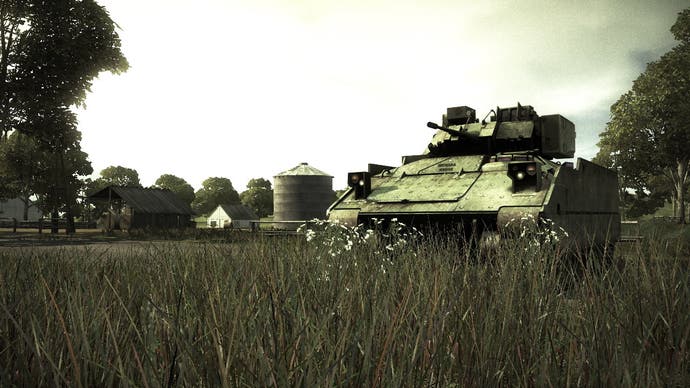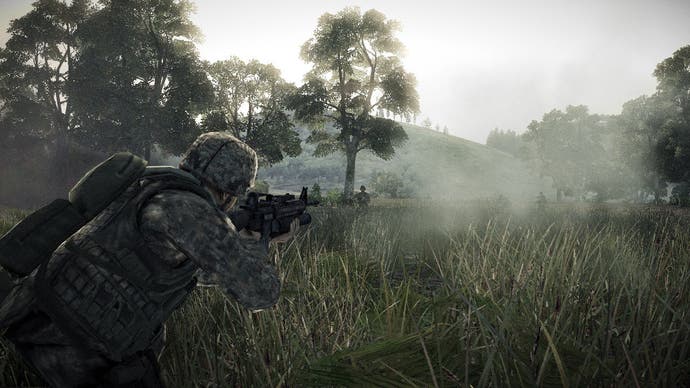Operation Flashpoint: Dragon Rising
War's a serious business.
Consulting soldiers recently returned from the Gulf and Afghanistan, experience plays an important role alongside technical accuracy. Lindop clarifies. "It's striking a balance between realism, which is all nuts and bolts and flying a space shuttle and pressing a thousand buttons, and the fact that in real life people are very intuitive." The game shouldn't be unapproachable just because it's realistic. "Firearms are designed to be used quickly by anybody, so the control methodology is really quite fluid. It's fast. Because the game's so lethal you don't want to blame the game when you die because it's like trying to drive a bus somewhere."
This is not to say it's going to be anything other than brutal. While there are difficulty settings, these aren't going to change how the AI treats you, or give you improved health. You're still a fleshy human even if you ask it to be easy. Instead you'll get more technical support. Easy will offer you a compass that shows you sighted enemies as red marks, and on-screen info gives you useful advantage. Put the difficulty up to its highest and you're not even going to get a crosshair.
There's obviously significant concern from the hardcore fans of the original PC version that this is coming out for 360, PS3, as well as PC. But this is something Codies is determined will surprise everyone. The engine has been specifically designed to achieve its enormous scale without burning out your console's chip, and as such will also not demand a top-of-the-range PC to play. However, play it on a top-notch PC and you're going to be able to scale it to look stunning. There's also not been any compromise in the features when switching to a controller. The quick-command system replaces the need for a keyboard full of buttons, and enormous amounts of work has been put into letting the analogue sticks provide something equivalent to mouse aiming without adding in any aim assist.

"The hardcore base don't want aim-assist," says Lindop. "We had an aim assist at one point, we did put it in just to see what the experience was like, but it was worse. You've got so many enemies on the battlefield. It's okay when the guy's ten foot from you, and you're in a street, and you say 'snap to that' and it does. But when there's thirty, forty, fifty guys on screen, and they're all very far away, you press snap and the system goes, 'Who?' There's about thirty guys within that tiny area."
However, it's not supposed to be too simple to master. Codies says it takes around twenty to thirty minutes for a player to become comfortable with the controls, but you'll find you'll only truly master certain aspects. "It's part of the system we want. The game rewards skill," Lindop explains. "We think players want to have that experience, to be able to say, 'I won because I'm good at the game. Not because the game carved a hole for me through this experience.'"
"Not everybody's going to be a great sniper. Others will be excellent. Some will find it tricky to do. This is one of the things I think the co-op will show is, because there's a genuine skill level in the game, then co-op will become a lot more meaningful and rewarding experience."

Co-op changes how the game is approached. In the single-player campaign you play as one character, and leave the sniping, etc., to the AI experts in your team. Enter co-op and you can play anyone you choose. In fact, if you're finding a particular section of the single-player game too difficult to pass, you can switch into co-op mode, get a few friends to help you out, and then drop back into offline mode and carry on.
Multiplayer opens up other opportunities. If just two of you create a private game, you can play like generals, commanding the AI from your Jeep on the hilltop. Or you can get up to 32 players on PC, 16 on 360/PS3 and have an all-out infantry war.
There are no plans for cross-platform multiplayer, Lindop citing the complete lack of a reason for it to exist. Not only do PC and console players tend to approach shooters differently, there's also a lot that makes a game like OPF:DR very hard to fairly balance. "The only thing that restricts draw distance is resolution. At about 500m a human on a 1080i is one pixel high. On a 1600x1200 screen he might be five or six pixels high. Even if the control methodology allowed them to be equally accurate, the PC guy has a slight edge. The PC guy needs less skill to make the shot than the 360 guy."

